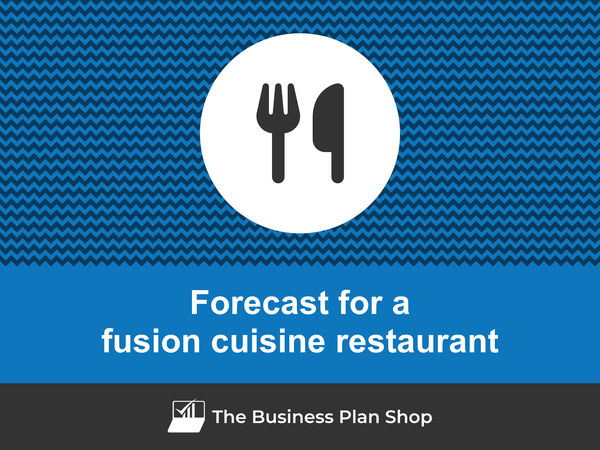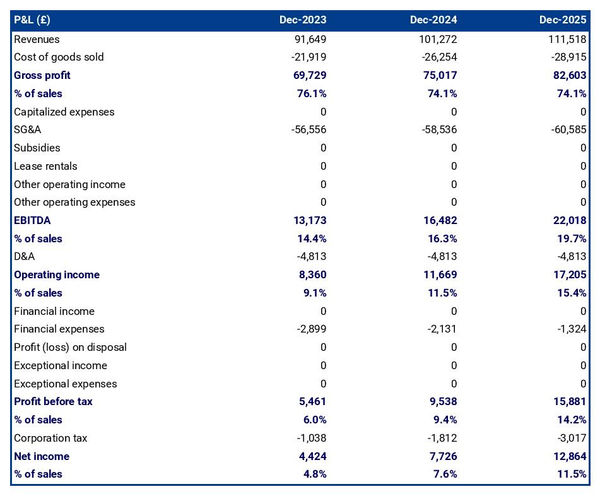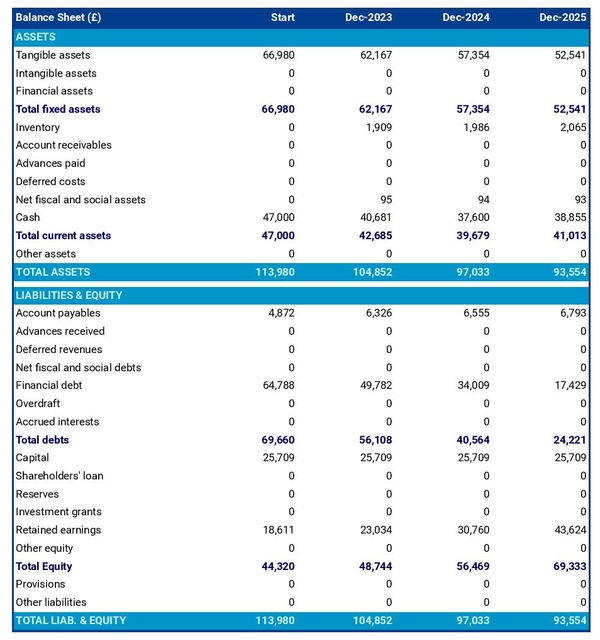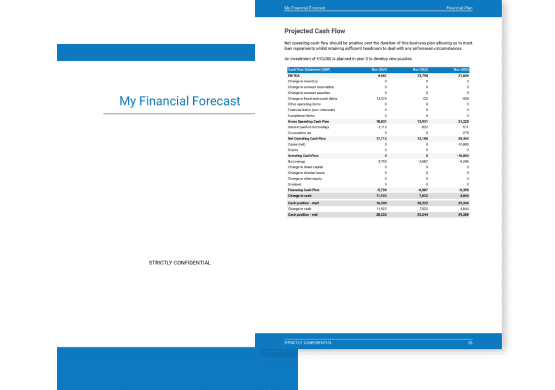How to create a financial forecast for a fusion cuisine restaurant?

Developing and maintaining an up-to-date financial forecast for your fusion cuisine restaurant is key in order to maintain visibility on your business’s future cash flows.
If you feel overwhelmed at the thought of putting together a fusion cuisine restaurant financial forecast then don’t worry as this guide is here to help you.
We'll cover everything from: the main objectives of a financial forecast, the data you need to gather before starting, to the tables that compose it, and the tools that will help you create and maintain your forecast efficiently.
Let's get started!
Why create and maintain a financial forecast for a fusion cuisine restaurant?
The financial projections for your fusion cuisine restaurant act as a financial blueprint to guide its growth with confidence and ensure its long-term financial viability.
To create them, you will need to look at your business in detail - from sales to operating costs and investments - to assess how much profit it can generate in the years to come and what will be the associated cash flows.
During challenging market conditions, maintaining an up-to-date financial forecast enables early detection of potential financial shortfalls, allowing for timely adjustments or securing financing before facing a cash crisis.
Your fusion cuisine restaurant's financial forecast will also prove invaluable when seeking financing. Banks and investors will undoubtedly request a thorough examination of your financial figures, making precision and presentation essential.
Need a solid financial forecast?
The Business Plan Shop does the maths for you. Simply enter your revenues, costs and investments. Click save and our online tool builds a three-way forecast for you instantly.

What information is used as input to build a fusion cuisine restaurant financial forecast?
A fusion cuisine restaurant's financial forecast needs to be built on the right foundation: your assumptions.
The data required to create your assumptions will depend on whether you are a new or existing fusion cuisine restaurant.
If you are creating (or updating) the forecast of an existing fusion cuisine restaurant, then your main inputs will be historical accounting data and operating metrics, and your team’s view on what to expect for the next three to five years.
If you are building financial projections for a new fusion cuisine restaurant startup, you will need to rely on market research to form your go-to-market strategy and derive your sales forecast.
For a new venture, you will also need an itemised list of resources needed for the fusion cuisine restaurant to operate, along with a list of equipment required to launch the venture (more on that below).
Now that you understand what is needed, let’s have a look at what elements will make up your fusion cuisine restaurant's financial forecast.
The sales forecast for a fusion cuisine restaurant
From experience, it is usually best to start creating your fusion cuisine restaurant financial forecast by your sales forecast.
To create an accurate sales forecast for your fusion cuisine restaurant, you will have to rely on the data collected in your market research, or if you're running an existing fusion cuisine restaurant, the historical data of the business, to estimate two key variables:
- The average price
- The number of monthly transactions
To get there, you will need to consider the following factors:
- Seasonal ingredients: As a fusion cuisine restaurant, you may use a variety of unique and seasonal ingredients in your dishes. These ingredients may be more expensive or harder to source during certain times of the year, leading to fluctuations in your average price.
- Menu changes: Your restaurant's menu is likely to change frequently as you experiment with different fusion dishes. These changes may affect your average price, as well as the number of monthly transactions as customers may be drawn to try new items.
- Special events and promotions: Hosting special events or offering promotions can attract new customers and increase the number of monthly transactions. However, these events may also affect your average price, depending on the discounts or specials offered.
- Competition: The presence of other fusion cuisine restaurants in your area may affect your average price and number of monthly transactions. If there are many similar options available, you may need to adjust your prices or offer unique dishes to stand out.
- Customer preferences: The preferences of your customers can also impact your average price and number of monthly transactions. For example, if fusion cuisine is a new concept in your area, it may take time to educate and attract customers, leading to lower average prices and transactions initially.
Once you have an idea of what your future sales will look like, it will be time to work on your overhead budget. Let’s see what this entails.
Need inspiration for your business plan?
The Business Plan Shop has dozens of business plan templates that you can use to get a clear idea of what a complete business plan looks like.

The operating expenses for a fusion cuisine restaurant
The next step is to estimate the expenses needed to run your fusion cuisine restaurant on a day-to-day basis.
These will vary based on the level of sales expected, and the location and size of your business.
But your fusion cuisine restaurant's operating expenses should include the following items at a minimum:
- Staff Costs: This includes the salaries and benefits for all of your employees, such as chefs, servers, and kitchen staff.
- Ingredients: The cost of purchasing high-quality, fresh ingredients is essential for any fusion cuisine restaurant.
- Rent: You will need to pay rent for your restaurant space, which can vary depending on location and size.
- Utilities: This includes electricity, gas, and water bills for your restaurant.
- Marketing and Advertising: To attract customers, you will need to invest in marketing and advertising strategies, such as social media ads and flyers.
- Accountancy Fees: Hiring an accountant to handle your finances and taxes is important for the success of your business.
- Insurance Costs: To protect your business, you will need to pay for insurance coverage, such as liability insurance.
- Software Licenses: You may need to purchase software licenses for your point-of-sale system, inventory management, and accounting software.
- Kitchen Supplies: This includes the cost of purchasing cooking utensils, pots and pans, and other essential kitchen items.
- Training and Development: To maintain high-quality food and service, you may need to invest in ongoing training and development for your staff.
- Cleaning and Maintenance: Keeping your restaurant clean and well-maintained is crucial for a positive dining experience, and this includes the cost of cleaning supplies and equipment.
- Banking Fees: You will need to pay fees for banking services, such as credit card processing fees and business account fees.
- Waste Management: Proper waste management, including garbage removal and recycling, is necessary for any restaurant.
- Licenses and Permits: You will need to obtain various licenses and permits to operate your restaurant legally.
- Music and Entertainment: If you plan on having live music or other forms of entertainment at your restaurant, you will need to budget for these costs.
This list is, of course, not exhaustive, and you'll have to adapt it according to your precise business model and size. A small fusion cuisine restaurant might not have the same level of expenditure as a larger one, for example.
What investments are needed to start or grow a fusion cuisine restaurant?
Once you have an idea of how much sales you could achieve and what it will cost to run your fusion cuisine restaurant, it is time to look into the equipment required to launch or expand the activity.
For a fusion cuisine restaurant, capital expenditures and initial working capital items could include:
- Kitchen Equipment: This includes items such as stoves, ovens, refrigerators, and other necessary appliances for your fusion cuisine restaurant. These items can be expensive, so it is important to budget for these in your expenditure forecast.
- Furniture and Decor: Your fusion cuisine restaurant will have a unique and eclectic style, so it is important to invest in high-quality furniture and decor pieces that will reflect this. This can include tables, chairs, lighting, and wall decor.
- Renovations and Remodeling: If you are opening a new restaurant or taking over an existing space, there may be renovations and remodeling required to bring your vision to life. This can include updating the kitchen layout, adding a bar area, or creating a unique dining space.
- Technology: In today's digital age, it is important for restaurants to have the latest technology to help with operations and customer experience. This can include POS systems, online ordering platforms, and reservation systems.
- Inventory and Supplies: As a fusion cuisine restaurant, you will need to stock your kitchen with a variety of ingredients and supplies from different cuisines. This can include spices, sauces, and specialty ingredients that may be more expensive than traditional restaurant supplies.
Again, this list will need to be adjusted according to the specificities of your fusion cuisine restaurant.
Need a convincing business plan?
The Business Plan Shop makes it easy to create a financial forecast to assess the potential profitability of your projects, and write a business plan that’ll wow investors.

The financing plan of your fusion cuisine restaurant
The next step in the creation of your financial forecast for your fusion cuisine restaurant is to think about how you might finance your business.
You will have to assess how much capital will come from shareholders (equity) and how much can be secured through banks.
Bank loans will have to be modelled so that you can separate the interest expenses from the repayments of principal, and include all this data in your forecast.
Issuing share capital and obtaining a bank loan are two of the most common ways that entrepreneurs finance their businesses.
What tables compose the financial plan for a fusion cuisine restaurant?
Now let's have a look at the main output tables of your fusion cuisine restaurant's financial forecast.
The forecasted profit & loss statement
The profit & loss forecast gives you a clear picture of your business’ expected growth over the first three to five years, and whether it’s likely to be profitable or not.

A healthy fusion cuisine restaurant's P&L statement should show:
- Sales growing at (minimum) or above (better) inflation
- Stable (minimum) or expanding (better) profit margins
- A healthy level of net profitability
This will of course depend on the stage of your business: numbers for an established fusion cuisine restaurant will look different than for a startup.
The projected balance sheet
Your fusion cuisine restaurant's projected balance sheet provides a snapshot of your business’s financial position at year-end.
It is composed of three types of elements: assets, liabilities and equity:
- Assets: represent what the business possesses including cash, equipment, and accounts receivable (money owed by clients).
- Liabilities: represent funds advanced to the business by lenders and other creditors. They include accounts payable (money owed to suppliers), taxes payable and loans from banks and financial institutions.
- Equity: is the combination of what has been invested by the business owners and the cumulative profits and losses generated by the business to date (which are called retained earnings). Equity is a proxy for the value of the owner's stake in the business.

The projected cash flow statement
A projected cash flow statement for a fusion cuisine restaurant is used to show how much cash the business is generating or consuming.

The cash flow forecast is usually organised by nature to show three key metrics:
- The operating cash flow: do the core business activities generate or consume cash?
- The investing cash flow: how much is the business investing in long-term assets (this is usually compared to the level of fixed assets on the balance sheet to assess whether the business is regularly maintaining and renewing its equipment)?
- The financing cash flow: is the business raising new financing or repaying financiers (debt repayment, dividends)?
Cash is king and keeping an eye on future cash flows is imperative for running a successful business. Therefore, you should pay close attention to your fusion cuisine restaurant's cash flow forecast.
If you are trying to secure financing, note that it is customary to provide both yearly and monthly cash flow forecasts in a financial plan - so that the reader can analyze seasonal variation and ensure the fusion cuisine restaurant is appropriately capitalised.
Need a solid financial forecast?
The Business Plan Shop does the maths for you. Simply enter your revenues, costs and investments. Click save and our online tool builds a three-way forecast for you instantly.

Which tool should you use to create your fusion cuisine restaurant's financial forecast?
Using the right tool or solution will make the creation of your fusion cuisine restaurant's financial forecast much easier than it sounds. Let’s explore the main options.
Using online financial projection software to build your fusion cuisine restaurant's forecast
The modern and easiest way to build a forecast is to use professional financial projection software such as the one we offer at The Business Plan Shop.
There are several advantages to using specialised software:
- You can easily create your financial forecast by letting the software take care of the financial calculations for you without errors
- You have access to complete financial forecast templates
- You get a complete financial forecast ready to be sent to your bank or investors
- You can easily track your actual financial performance against your financial forecast, and recalibrate your forecast as the year goes by
- You can create scenarios to stress test your forecast's main assumptions
- You can easily update your forecast as time goes by to maintain visibility on future cash flows
- You have a friendly support team on standby to assist you when you are stuck
- It’s cost-efficient and much cheaper than using an accountant or consultant (see below)
If you are interested in this type of solution, you can try our forecasting software for free by signing up here.
Hiring a financial consultant or chartered accountant
Hiring a consultant or chartered accountant is also an efficient way to get a professional fusion cuisine restaurant financial projection.
As you can imagine, this solution is much more expensive than using software. From experience, the creation of a simple financial forecast over three years (including a balance sheet, income statement, and cash flow statement) is likely to start around £700 or $1,000 excluding taxes.
The indicative estimate above, is for a small business, and a forecast done as a one-off. Using a financial consultant or accountant to track your actuals vs. forecast and to keep your financial forecast up to date on a monthly or quarterly basis will naturally cost a lot more.
If you choose this solution, make sure your service provider has first-hand experience in your industry, so that they may challenge your assumptions and offer insights (as opposed to just taking your figures at face value to create the forecast’s financial statements).
Why not use a spreadsheet such as Excel or Google Sheets to build your fusion cuisine restaurant's financial forecast?
Creating an accurate and error-free fusion cuisine restaurant financial forecast with a spreadsheet is very technical and requires a deep knowledge of accounting and an understanding of financial modelling.
Very few business owners are financially savvy enough to be able to build a forecast themselves on Excel without making mistakes.
Lenders and investors know this, which is why forecasts created on Excel by the business owner are often frowned upon.
Having numbers one can trust is key when it comes to financial forecasting and to that end using software is much safer.
Using financial forecasting software is also faster than using a spreadsheet, and, with the rise of artificial intelligence, software is also becoming smarter at helping us analyse the numbers to make smarter decisions.
Finally, like everything with spreadsheets, tracking actuals vs. forecasts and keeping your projections up to date as the year progresses is manual, tedious, and error-prone. Whereas financial projection software like The Business Plan Shop is built for this.
Need a convincing business plan?
The Business Plan Shop makes it easy to create a financial forecast to assess the potential profitability of your projects, and write a business plan that’ll wow investors.

Use our financial projection templates for inspiration
The Business Plan Shop has dozens of financial forecasting templates available.
Our examples contain both the financial forecast, and a written business plan which presents, in detail, the company, the team, the strategy, and the medium-term objectives.
Whether you are just starting out or already have your own fusion cuisine restaurant, looking at our template is always a good way to get ideas on how to model financial items and what to write when creating a business plan to secure funding.

Takeaways
- Having a financial forecast enables you to visualise the expected growth, profitability, and cash generation for your business over the next three to five years.
- Tracking actuals vs. forecast and keeping your financial projections up-to-date is the only way to get a view on what your fusion cuisine restaurant future cash flows may look like.
- Using financial forecasting software is the mordern and easy way to create and maintain your forecasts.
This is the end of our guide on how to build the financial forecast for a fusion cuisine restaurant, we hope you found it useful. Don't hesitate to contact us if you want to share your feedback or have any questions.
Need inspiration for your business plan?
The Business Plan Shop has dozens of business plan templates that you can use to get a clear idea of what a complete business plan looks like.

Also on The Business Plan Shop
Know someone who owns or is thinking of starting a fusion cuisine restaurant? Share our forecasting guide with them!




